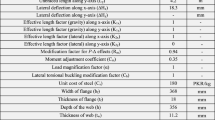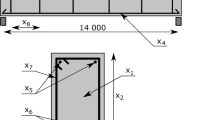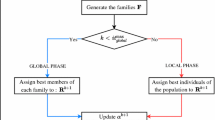Abstract
This paper describes a novel method to select the optimal member sizes and connection types for steel frame structures to minimize total installed cost. The proposed dimension increasing search (DIS) method addresses geometric constraints associated with connection, safety, and serviceability constraints. Solving this optimization problem requires addressing a non-convex objective function of total installed cost, a large number of constraints, the time-consuming structural analysis for evaluation of the constraints, and intractability resulting from high-dimensional variables. The DIS method involves initial grouping of design variables to reduce the search dimension from the original dimension. Random search coupled with forward checking and branch-and-bound techniques are then employed to optimize the configuration of the steel frame. This approach eliminates designs that are more expensive or do not satisfy geometric constraints without performing structural analysis. The variable groups are then split into subgroups to increase the search dimension, and the increased dimensional design variables are optimized until the original search dimension is achieved. We benchmarked the DIS method against leading methods using three numerical examples with increasing problem scales. The DIS method was more computationally efficient compared to other leading methods by an order of magnitude, and the solutions found by the method have a 9% lower total installed cost on average. The DIS method also showed scalability; the computational time increased only slightly as the problem scale increased. The scalability of the DIS method demonstrates the potential for its successful industrial application to large-scale building projects.















Similar content being viewed by others
Abbreviations
- \({\varvec{x}}\) :
-
Sizing variables
- \(t\) :
-
Connection type variable
- \(f\) :
-
Total installed cost function
- \(c\) :
-
Safety and serviceability constraints
- \(g\) :
-
Geometric constraints
- \({f}^{i}\) :
-
Optimal solution in the \(i\) th stage
- \({d}^{i}\) :
-
The search dimension in the \(i\) th stage
- \({f}_{m}\) :
-
Member sizing cost
- \({f}_{c}\) :
-
Connection cost
- \({\xi }_{j}^{k}\) :
-
A stochastic movement size for \(j\) th element in variable at \(k\) th step in random walk
- \({s}_{max}\) :
-
Maximum step size in random search
- \(p{^{\prime}}\) :
-
A random number between 0 and 1 to determine the step size
- \({x}_{j}^{k}\) :
-
The \(j\)th element in variable \(x\) , at \(k\) th step in random search
- \(dt\) :
-
Decreasing threshold
- \(p\) :
-
A random number between 0 and 1 to determine the moving direction in random research
- \(it\) :
-
Increasing threshold
- \({n}_{max\_width}\) :
-
The maximum search width
- \({n}_{max\_depth}\) :
-
The maximum search depth
- \({G}_{i,s}\) :
-
Variable group \(s\) at stage \(i\)
- \({\sigma }_{i}\) :
-
The stress at steel member \(i\)
- \({\sigma }_{i}^{a}\) :
-
The allowable stress at steel member \(i\)
- \({P}_{u}\) :
-
The required axial strength
- \({M}_{uy}\) :
-
The normal flexural strength in y direction
- \({\phi }_{b}\) :
-
The flexural reduction factor
- \({M}_{ny}\) :
-
The required flexural strength in the y direction
- \({\phi }_{c}\) :
-
The resistance factor
- \({P}_{n}\) :
-
The normal axial strength
- \({M}_{ux}\) :
-
The normal flexural strength in x direction
- \({M}_{nx}\) :
-
Required flexural strength in the x direction
- \({d}_{k}\) :
-
The inner-story displacement
- \({d}_{k}^{a}\) :
-
The allowable inner-story displacement
- \({D}^{k,l}\) :
-
The lower bound for the connection’s dimension property
- \({D}_{j}^{k}\) :
-
The dimension property for connection \(j\)
- \({D}^{k,u}\) :
-
The upper bound for the connection’s dimension property
References
Alberdi R, Murren P, Khandelwal K (2015) Connection topology optimization of steel moment frames using metaheuristic algorithms. Eng Struct 100:276–292
Aydoğdu I, Akın A, Saka MP (2012) Optimum design of steel space frames by artificial bee colony algorithm. In: 10th international congress on advances in civil engineering. vol 3, no 10, pp 17–19
Babaei M, Mollayi M (2020) An improved constrained differential evolution for optimal design of steel frames with discrete variables. Mech Based Des Struct Mach 48(6):697–723
Barg S, Flager F, Fischer M (2015) Decomposition strategies for building envelope design optimization problems. In: Symp Simul Archit Urban Des SimAUD 2015. vol 47, no 7, pp 95–102
Barg S, Flager F, Fischer M (2017) An analytical method to estimate the total installed cost of structural steel building frames during early design. J Build Eng 15:41–50
Barg S, Flager F, Fischer M (2020) A design-focused, cost-ranked, structural-frame sizing optimization. J Build Eng 30:101269
Bel Hadj Ali N, Sellami M, Cutting-Decelle AF, Mangin JC (2009) Multi-stage production cost optimization of semi-rigid steel frames using genetic algorithms. Eng Struct 31(11):2766–2778
Camp CV, Bichon BJ, Stovall SP (2005) Design of steel frames using ant colony optimization. J Struct Eng 131(3):369–379
Carbas S (2016) Design optimization of steel frames using an enhanced firefly algorithm. Eng Optim 48(12):2007–2025
Degertekin SO (2009) Optimum design of steel frames via harmony search algorithm. Stud Comput Intell 239:51–78
Degertekin SO, Hayalioglu MS (2010) Harmony search algorithm for minimum cost design of steel frames with semi-rigid connections and column bases. Struct Multidiscip Optim 42(5):755–768
Díaz C, Victoria M, Querin OM, Martí P (2012) Optimum design of semi-rigid connections using metamodels. J Constr Steel Res 78:97–106
Flager F, Adya A, Haymaker J, Fischer M (2014) A bi-level hierarchical method for shape and member sizing optimization of steel truss structures. Comput Struct 131:1–11
Freuder EC, Quinn MJ (1985) Taking advantage of stable sets of variables in constraint satisfaction problems. Computer (Long. Beach. Calif).
Gholizadeh S, Milany A (2018) An improved fireworks algorithm for discrete sizing optimization of steel skeletal structures. Eng Optim 50(11):1829–1849
Hadidi A, Rafiee A (2015) A new hybrid algorithm for simultaneous size and semi-rigid connection type optimization of steel frames. Int J Steel Struct 15(1):89–102
Hayalioglu MS, Degertekin SO (2005) Minimum cost design of steel frames with semi-rigid connections and column bases via genetic optimization. Comput Struct 83(21–22):1849–1863
Kaveh A, Ghazaan MI (2017) Enhanced whale optimization algorithm for sizing optimization of skeletal structures. Mech Based Des Struct Mach 45(3):345–362
Kaveh A, Javadi M (2019) Chaos-based firefly algorithms for optimization of cyclically large-size braced steel domes with multiple frequency constraints. Comput Struct 214:28–39
Kaveh A, Talatahari S (2010) Optimum design of skeletal structures using imperialist competitive algorithm. Comput Struct 88(21–22):1220–1229
Kaveh A, Bakhshpoori T, Ashoory M (2012) An efficient optimization procedure based on cuckoo search algorithm for practical design of steel structures. Int J Optim Civ Eng 2(1):1–14
Kaveh A, Khodadadi N, Azar BF, Talatahari S (2020) Optimal design of large-scale frames with an advanced charged system search algorithm using box-shaped sections. Eng Comput. https://doi.org/10.1007/s00366-020-00955-7
Kicinger R, Arciszewski T, De Jong K (2005) Evolutionary computation and structural design: a survey of the state-of-the-art. Comput Struct 83(23–24):1943–1978
Kripakaran P, Hall B, Gupta A (2011) A genetic algorithm for design of moment-resisting steel frames. Struct Multidiscip Optim 44(4):559–574
Lawler EL, Wood DE (1966) Branch-and-bound methods : a survey. Oper Res 14(4):699–719
Lovasz L (1993) Random walks on graphs: a survey. Combinatorics 2(2):1–46
Maatje F, Evers HGA (2004) The constructable structure in steel. In: Connections in steel structures. vol V, pp 27–36
Pezeshk S, Camp CV, Chen D (2000) Design of nonlinear framed structures using genetic optimization. J Struct Eng 126(March):382–388
Serpik I (2018) Parametric optimization of steel frames using the job search inspired strategy. Energy Manag Munic Transp Facil Transp, EMMFT-2018: 682–691
Solis FJ, Wets RJ-B (1981) Minimization by random search techniques. Math Oper Res 6(1):19–30
Steel Construction Institute (2013) Joint in steel construction: moment-resisting joints to Eurocode 3
SteelCentral, http://gerdau.steelcentral.com Gerdau, 2016.
Tayfur B, Yilmaz H, Daloğlu AT (2020) Hybrid tabu search algorithm for weight optimization of planar steel frames. Eng Optim 53(8):1369–1383
Wang X, Zhang Q, Qin X, Sun Y (2020) An efficient discrete optimization algorithm for performance-based design optimization of steel frames. Adv Struct Eng 23(3):411–423
Wood D, Adams BR, Beaulieu PF (1976) Column design by p-delta method. J Struct Div 102(2):411–427
Woodbury RF, Burrow AL (2006) Whither design space? Artif Intell Eng Des Anal Manuf AIEDAM 20(2):63–82
Acknowledgements
The authors would like to thank CIFE (Center for Integrated Facility Engineering at Stanford University) for the funding provided and the access to computational resources. We also appreciate the software support provided by Autodesk, especially Patrick Tierney.
Author information
Authors and Affiliations
Corresponding author
Ethics declarations
Conflict of interest
This research was funded by Autodesk and CIFE. Besides, there is no conflict of interests with other people and institute.
Additional information
Publisher's Note
Springer Nature remains neutral with regard to jurisdictional claims in published maps and institutional affiliations.
Appendix A: Detailing parameters
Appendix A: Detailing parameters
See Table 7.
1.1 Replication of results
We attached the code for the experiments mentioned in the Sect. 4 (Table 8). Three folders are corresponding to the numerical experiments of three steel frames. The cost data applied in this paper is explained in the work of Barg et al. (2017).
Rights and permissions
About this article
Cite this article
Peng, B., Flager, F., Barg, S. et al. Cost-based optimization of steel frame member sizing and connection type using dimension increasing search. Optim Eng 23, 1525–1558 (2022). https://doi.org/10.1007/s11081-021-09665-5
Received:
Revised:
Accepted:
Published:
Issue Date:
DOI: https://doi.org/10.1007/s11081-021-09665-5




